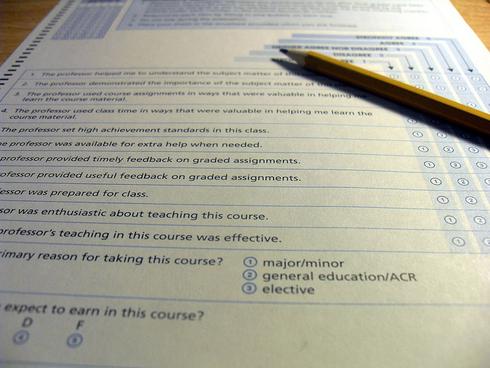By Allison Navadomskis
Contributing Writer
At the end of every class, North Central students are asked to fill out course evaluations. The sheet asks for student’s opinions on how well the professor taught the course. Once the questionnaires are completed, a student drops them off in receptacles on campus.
Becca Sandow tells me she “normally” takes course evaluations seriously. “There was a class where one of the students said, ‘hey, we should all write something funny,’” she recalls. Another student suggested they all comment on their professor’s hair. Sandow says the professor “emailed us early the next term… The title of the email was ‘you are all meatballs.’”
Sandow has a positive opinion on course evaluations. “I like that we can give feedback in a way that more students are comfortable with, that can improve the teaching experience,” she says.
Another student, senior Melissa Aponte, says she also takes evaluations seriously, but she has one issue with them: “I want to know what they’re used for. For me, it’s important for them to know how I feel about a teacher… but then again, I don’t know where it’s going. I don’t know if I’m helping or if it’s just a paper that gets thrown away.”
A call to the academic affairs office revealed that evaluations are kept on file in the department of the professor, and they are used when the professor is assessed by the Faculty Personnel Committee, or FPC.
Two professors shared their experiences with course evaluations. Professor Steven Maynard Caliendo is a tenured professor of political science and chairperson of the human thought and behavior division. Professor Paul Mullen is adjunct associate professor of psychology.
Professors receive the course evaluations soon after grades are submitted. Along with the evaluations comes a summary sheet, which tells the professor the average evaluation scores for the course, along with the college average so the professor can compare. Then, the evaluations are put away until the professor’s review.
Caliendo explains, “We’re supposed to read them… then give them back to the division secretary. When we’re ready for our review period… we can retrieve the ones that we need, and include them in a big file… that includes all the course evals as well as syllabi and assignments, and a narrative where we reflect on our teaching, and our service and our research.”
Tenure-track professors are reviewed by the college every year until they are granted tenure. After that, the professor is evaluated every five years. Half-time professors, like Mullen, are reviewed yearly. Mullen says, “A person who’s half-time has a contract annually—so, every year, the commitment is for one more year.” Even though half-time professors may not be trying for tenure, the course evaluations still play a role in any promotions the professors apply for.
The course evaluation a student fills out is read by multiple people and can have a big impact on a professor. Caliendo says, “It’s not just read by the faculty member, it’s read by the department chairperson, and it’s read by the division chairperson. Most of the time, it’s also read by six people on the tenure promotion committee, as well as the academic dean. When a student writes something, lots of people are going to read what that student writes.”
Rather than not think about the evaluations until the end of the class, professors should keep them in mind throughout the term, along with the feedback they’ve received in the past. Mullen says that he tries to do this.
For example, one of the items on the course evaluation is providing feedback on assignments. Mullen says, “I’m not going to be one of those people who hands back a paper with a mystery number at the top and somehow it’s been magically divined. I’m going to make sure to put comments. A, because it’s the best thing to do, but B, I know someone’s going to be asked in six weeks, ‘did he give you comments?’”
Course evaluations have a big impact on professors, so students should fill them out thoughtfully. Mullen says to especially think about the written portion “That is the part that is potentially the most valuable. If you’re not the type to fill out the narrative part, try to push yourself to be that person, because it’s really appreciated and helpful.”


1 Comment
Pingback: Writing Samples | Allison Navadomskis audio samples